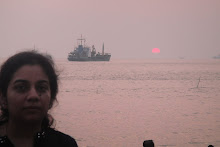Author :
Jeanne Duprau
Publisher
: Random House
Another gem of a book introduced to us by my sister and her children.
There is
something strange about the city of Ember. It is night everywhere but no
twinkling stars and no moon in the sky. There are no plants and animals except
for bugs and insects. It is dark all the time except for the yellow lights that
flicker from the lamps in the houses and on the streets. Since there is no
notion of day or night, the activities happen as per the specific timings. The
lights are put out at certain hour every day indicating bed time and the lights
are turned on after specific passage of time every day. Everywhere everything
seems to be bathed in an ominous yellow glow but still the brightness is
missing. Beyond the area that is lit by these floodlamps there is a black scary
world that no one has dared venture into. In fact, some people did try
exploring that part of the city but were not successful in finding anything
after just a few steps in the pitch dark unknown world. The life has been going
on in the city as a rhythm, or is it so? Though people have been living here
for more than 240 years, it is becoming more and more noticeable that the
storerooms are running out of supplies, things are getting scarcer by every day
and the city is plunging into blackouts more often now, bringing everything to
standstill. In short, uncertainty is looming large over the future of the city
and its inhabitants. This underlying fear is getting reflected in the
gloominess that is writ large on the faces of citizens of Ember.
One more
school term is over and twelve-year-old Doon Harrow and Lina Mayfleet have been
assigned their life jobs - Lina as a messenger, and Doon as Pipeworker. The
lifeline of the city - the pipeworks are underground where a river roars and a
generator works untiringly, illuminating the whole city. Doon believes that he
would find something there among the pipes which could possibly change the
doomed future of the city. Lina happens to find an old document titled -
'Instructions for Egress', (Egress means exit) in a torn state and along with
Doon she decides to solve the puzzle to find the new world. These happen to be
the instructions that were written by the builders of the city some 241 years
ago to lead the people out at the right time. But clearly something went wrong
in the way it was supposed to get passed on from one generation to another.
While on
their mission to find directions out of the city, they stumble upon some
unflattering secrets about the mayor of the city and his guards. Doon and Lina
now face a prison sentence for spreading false rumours. Time is ticking, the
guards are looking for them, Doon and Lina have to decide fast and act fast.
They have to decipher the mysterious instructions and the task becomes even
more difficult when they do not even know what do things like matchsticks,
candle and boat mean. Will they every see any light at the other end of the
tunnel?
'The City
of Ember' is full of fear, mystery, adventure, and desire and determination of
two pre-teens to save the people of their city. The narration is engaging and
it is interesting how the strangeness of the city is unraveled slowly chapter
after chapter. While smoothly weaving the flow of the story, the author very
subtly talks about the 'want' in a person which often plagues any logic or
reason that comes in its way. Lina experiences this feeling once when on seeing
the colour pencils in the store which she so desperately desired, she finds the
'need' of a coat for her grandmother fading away. It was perhaps the same
'want' which had cast its spell on the mayor and his trusted people too,
including one of Lina's friends.
If you want to know what happened to the people of Ember, you need to read the sequel of this book - The People of Sparks.










.png)








